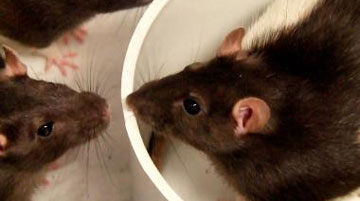Whiskers and the Sense of Touch
About
 Rats are expert at navigating the world in the dark using their sense of touch. They rhythmically brush and tap about 60 large vibrissae (whiskers) against objects to determine object size, shape, orientation, and texture. This behavior is called “whisking.” Whiskers have no sensors along their length; instead, all mechanosensory information is transmitted to sensors located only in the follicle at the whisker base.
Rats are expert at navigating the world in the dark using their sense of touch. They rhythmically brush and tap about 60 large vibrissae (whiskers) against objects to determine object size, shape, orientation, and texture. This behavior is called “whisking.” Whiskers have no sensors along their length; instead, all mechanosensory information is transmitted to sensors located only in the follicle at the whisker base.
Imagine, now, that we could quantify the head movements of the rat, as well as the mechanical signals at the base of each and every whisker as the rat tactually explores its world. We would then have access to all of the primary mechanical information that the nervous system requires in order for the animal to perceive its environment through vibrissal-mediated touch.
Our approach is twofold, using both behavioral and computational techniques. We first present two videos that provide an overview of our research. Next, we describe some of our work quantifying rat whisking behavior with high speed video, and simulating rat whisking behavior using the Digital Rat.
Two videos that provide an overview of our research
This interview and video from National Public Radio’s program Science Friday explains some ways our laboratory is investigating the sense of touch and sensorimotor integration. When a whisker bends against an object, forces and torques are generated at the whisker base. By quantifying these mechanical signals we are able to begin to understand what information the brain is receiving.
Another video from PBS (Science Bytes) illustrates the whisker pathway in rats and its similarity to the human hand and sense of touch. It also highlights some of our computational approaches to understanding whisking and the whisker system as well as potential applications as a whisker-based “tactile brush.” High-speed video is used to quantify rat whisking behavior in Episode 2: Whisker Wonders from Science Bytes on Vimeo.
To study whisking behavior we use high-speed video to track the whiskers at frame rates up to 3000 frames per second. Some of our work has shown that whisking movements are extremely flexible – the whiskers do not need to move synchronously or symmetrically on the two sides of the face (Towal and Hartmann, 2006), and protractions often involve a slight “forward-back” motion in the middle of the whisk (Towal and Hartmann, 2008). These studies have also underscored the idea that whisking movements are tightly locked to head movements. In particular, we have learned that the magnitude of the spatial asymmetry of the whiskers on right and left sides of the rat’s face directly predicts where the rat’s head will be at the start of the next whisk.
While whisking has a rhythmic regularity, there is also a tremendous amount of variability seen during whisking. Here we see four types of whisking observed during exploration of an object:
Simulating rat whisking behavior
On the computational side, we use a 3D model of the rat vibrissal array (the Digital Rat) to quantify vibrissal-object contact patterns as the rat is simulated to explore various objects. This allows the spatiotemporal patterns of vibrissal-object contact to be quantified. These contact patterns begin to allow us to understand what information may be useful for the rat. To complement these investigations of the geometry of contact, we also quantify how whisker mechanics contribute to the signals available to the rat to extract object properties.
People
Mitra Hartmann
Yan Man
Lucie Huet
Related Publications
Representation of Stimulus Speed and Direction in Vibrissal-Sensitive Regions of the Trigeminal Nuclei A Comparison of Single Unit and Population Responses, PLOS ONE, vol. 11, no. 7, pp. e0158399, Jul-27-2016/ 2016 DOI Google Scholar
Whisking Kinematics Enables Object Localization in Head-Centered Coordinates Based on Tactile Information from a Single Vibrissa, Frontiers in Behavioral Neuroscience, vol. 10, pp. Article 145, Jul-19-2016/ 2016 DOI Google Scholar
The search space of the rat during whisking behavior, Journal of Experimental Biology, vol. 217, no. 18, pp. 3365 - 3376, 09/2014/ 2014 DOI Google Scholar
The morphology of the rat vibrissal array a model for quantifying spatiotemporal patterns of whisker-object contact, PLoS computational biology, vol. 7, Public Library of Science, pp. e1001120, 2011 Google Scholar
Variability in velocity profiles during free-air whisking behavior of unrestrained rats, Journal of neurophysiology, vol. 100, Am Physiological Soc, pp. 740-752, 2008 Google Scholar
Right-left asymmetries in the whisking behavior of rats anticipate head movements, The Journal of neuroscience, vol. 26, Soc Neuroscience, pp. 8838-8846, 2006 Google Scholar
Active sensing capabilities of the rat whisker system, Autonomous Robots, vol. 11, Springer, pp. 249-254, 2001 Google Scholar
Back to top